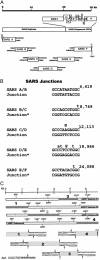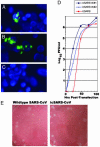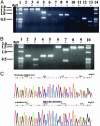Reverse genetics with a full-length infectious cDNA of severe acute respiratory syndrome coronavirus
- PMID: 14569023
- PMCID: PMC240733
- DOI: 10.1073/pnas.1735582100
Reverse genetics with a full-length infectious cDNA of severe acute respiratory syndrome coronavirus
Abstract
A previously undescribed coronavirus (CoV) is the etiologic agent responsible for severe acute respiratory syndrome (SARS). Using a panel of contiguous cDNAs that span the entire genome, we have assembled a full-length cDNA of the SARS-CoV Urbani strain, and have rescued molecularly cloned SARS viruses (infectious clone SARS-CoV) that contained the expected marker mutations inserted into the component clones. Recombinant viruses replicated as efficiently as WT virus and both were inhibited by treatment with the cysteine proteinase inhibitor (2S,3S)-transepoxysuccinyl-L-leucylamido-3-methylbutane ethyl ester. In addition, subgenomic transcripts were initiated from the consensus sequence ACGAAC in both the WT and infectious clone SARS-CoV. Availability of a SARS-CoV full-length cDNA provides a template for manipulation of the viral genome, allowing for the rapid and rational development and testing of candidate vaccines and therapeutics against this important human pathogen.
Figures




References
-
- Tsang, K. W., Ho, P. L., Ooi, G. C., Yee, W. K., Wang, T., Chan-Yeung, M., Lam, W. K., Seto, W. H., Yam, L. Y., Cheung, T. M., et al. (2003) N. Engl. J. Med. 348 1977-1985. - PubMed
-
- Lee, N., Hui, D., Wu, A., Chan, P., Cameron, P., Joynt, G. M., Ahuja, A., Yung, M. Y., Leung, C. B, To, K. F., et al. (2003) N. Engl. J. Med. 348 1986-1994. - PubMed
-
- Poutanen, S. M., Low, D. E., Henry, B., Finkelstein, S., Rose, D., Green, K., Tellier, R., Draker, R., Adachi, D., Ayers, M., et al. (2003) N. Engl. J. Med. 348 1995-2005. - PubMed
Publication types
MeSH terms
Substances
Grants and funding
LinkOut - more resources
Full Text Sources
Other Literature Sources
Miscellaneous

